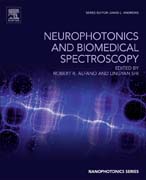
Neurons, the basic building blocks of the nervous systems consist of billions in a tree-like structure which function and behavior forms the basis of understanding and manipulating neural activity. Direct stimulation on neural cells and tissues using electric, ultrasound and light has been tremendous interest and opportunity to alter brain function and Blood Brain Barrier (BBB). Infrared light can be used to stimulate neural activity in the peripheral and central nervous system. Light-based technologies with different wavelengths from the UV through the infrared have been applied to stimulate neural tissue and cells. The mechanism of light induced neural activation can be initiated. Novel optically inducible ion channels such as the opsins in optogentics for neural targeting, present an additional dimension to research. Neurophotonics and Biomedical Spectroscopy addresses these issues in two parts: Part 1 presents the novel state-of-the-art work in non-invasive optical spectroscopic methods to detect the onset and progression of diseases, including pre-malignancy , cancer ,and Alzheimer's disease, and tissue and cell response to external conditions such as therapeutic intervention, unintended injury, and laser energy deposition. Part 2 highlights research in neurophotonics that investigates single and multi-photon excitation optical signatures of normal/ diseased nerve tissues and brain, for better understanding the underlying biochemical and structural changes of tissues and cells that are responsible for the observed spectroscopic signatures. The topics cover a wide array of well-established UV, visible, NIR and IR optical and spectroscopic techniques and novel approaches to diagnose tissue changes, including: label free in vivo and ex vivo fluorescence spectroscopy, Stoke shift spectroscopy, spectral imaging, Resonance Raman spectroscopy, multiphoton two Photon excitation , second harmonic, third harmonic and NIR photonic imaging methods, to detect tissue or body fluids properties and functions implemented in vivo or ex vivo covering the technology development from bench-to-bedside. Provides an overview of the spectroscopic properties of tissue and tissue-light interaction, describing techniques to exploit these properties in imagingExplores the potential and significance of molecule-specific imaging, and its capacity to reveal vital new information on nanoscale structuresOffers a concise overview of different spectroscopic methods and their potential benefits for solving diagnostic and therapeutic problems INDICE: Part 1: Topics in Optical Spectroscopy Biopsy 1. Origin of tissue optical properties 2. Optical methods for tissue diagnosis and treatment 3. Methods for in vivo assessment of physiological state of tissue 4. Excitation, absorption, scattering fluorescence spectroscopy 5. Resonance Raman spectroscopy 6. Inelastic light scattering spectroscopy and imaging 7. Stimulated Raman gain spectroscopy and imaging-NIR optical windows in 700 nm to 2500 nm 8. Coherent and non-contact photo-acoustic imaging 9. Polarization and diffusive reflectance spectral imaging time resolved spectroscopy single and multi photon excitation and imaging 10. Mid infrared diagnostic methods 11. Nano particle tagging and contrast agents optical metabolomics Demos , Gansean 12. Supercontinuum for medical and biological applications 13. Stokes shift spectroscopy Part 2: Topics in Optics in Brain 14. Alzheimer's Disease optical Imaging in vascular impairment 15. Hemodynamics by NIR in Brain, and Overview View summary of field 16. Blood Barrier in mice using two photon and ultrasound 17. Overview of Infrared neural stimulation 18. 2Photon excitation in brain 19. Overview NIR correlation spectroscopy in brain 20. Overview of Optical Coherent Tomography in neuron tree 21. IR stimulation in spinal nerves 22. Ca+2 channels in brain by multiphotons 23. Ca2+ flow in brain by multiphotons 24. Overview Ca2+ indicators by 2PEF 25. Control Biosystems using optogentics 26. Optogenetic circuit mapping with traditional whole cell patch clamp to determine synaptic connectivity between identified neurons in mouse models of psychiatric disease 27. Special Proteins Red fluorescent proteins RFP in brain probing(Dr. Robert Campbell) 28. OCT neural activity 29. Stimulated Raman Scattering Microscopy in Brain Research 30. Imaging the neurovascular coupling system with laminar optical tomography and hyperspectral two-photon microscopy 31. Multi photon Imaging in neuroscience
- ISBN: 978-0-323-48067-3
- Editorial: William Andrew
- Encuadernacion: Cartoné
- Páginas: 400
- Fecha Publicación: 01/04/2018
- Nº Volúmenes: 1
- Idioma: Inglés
